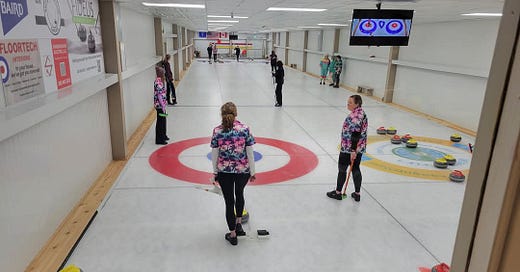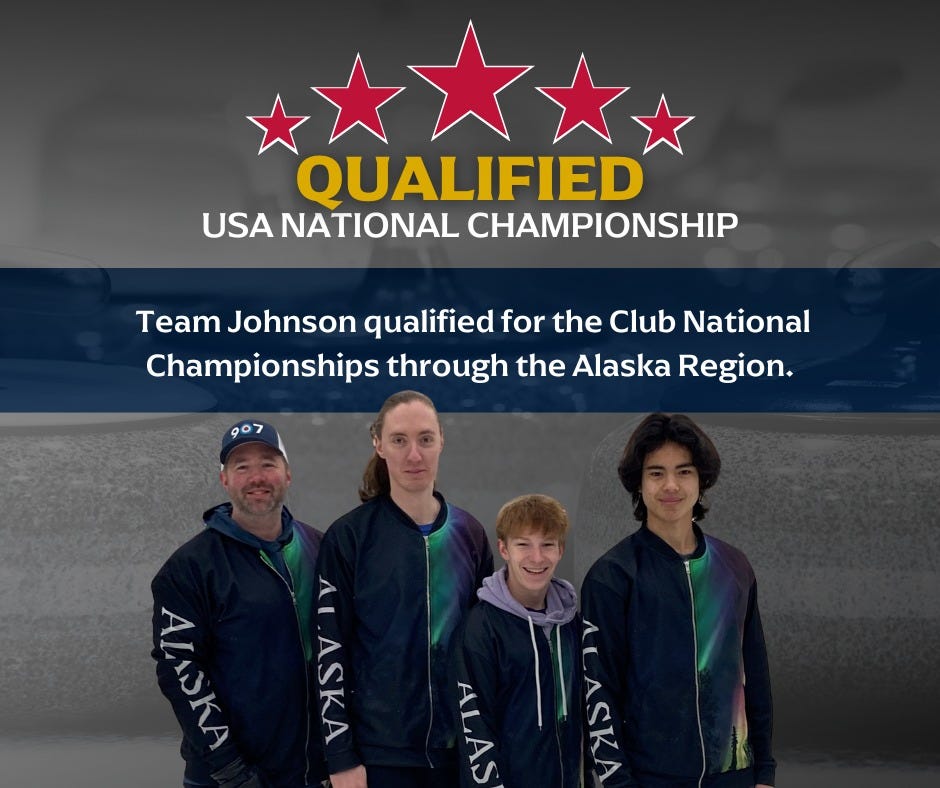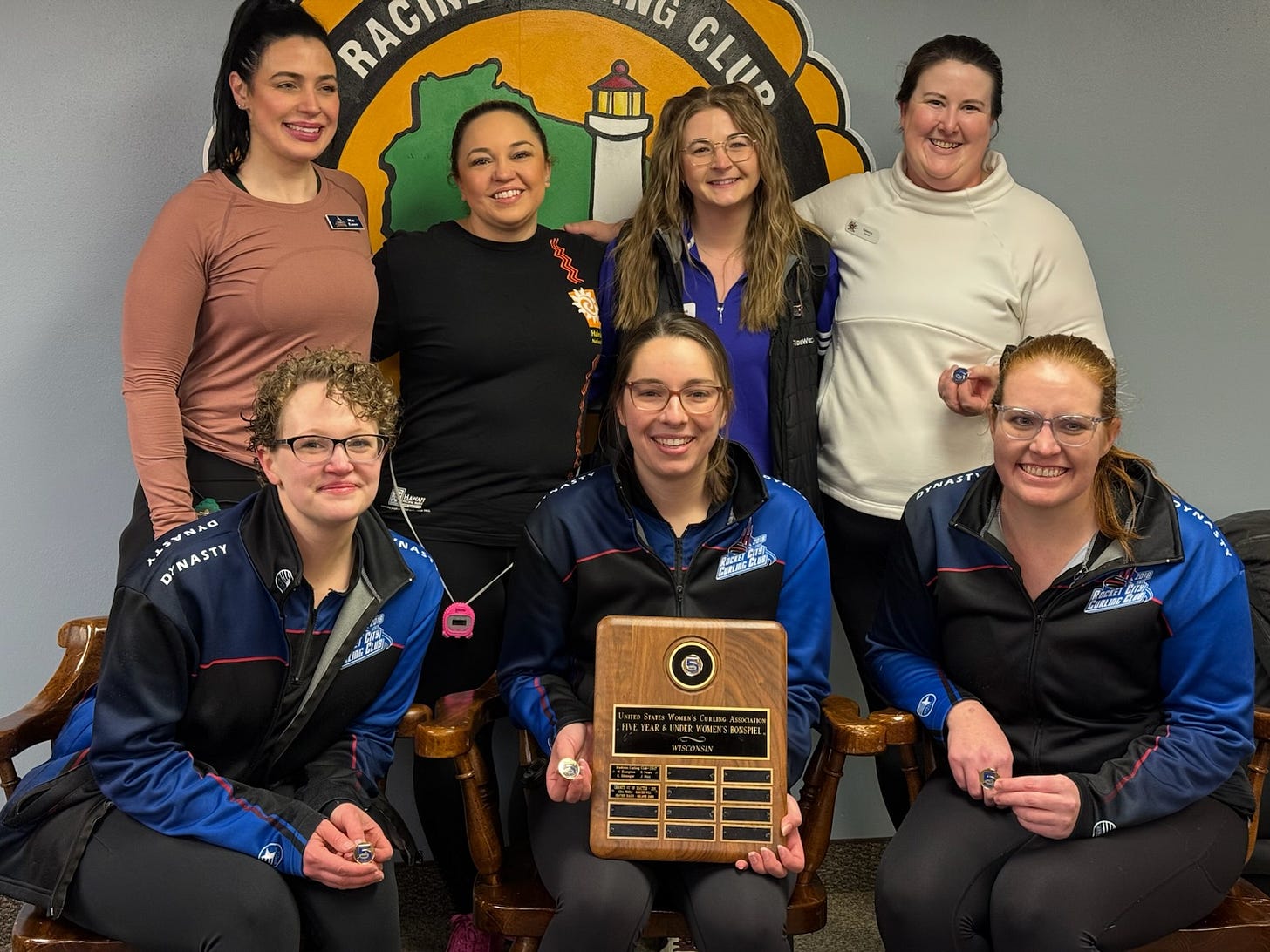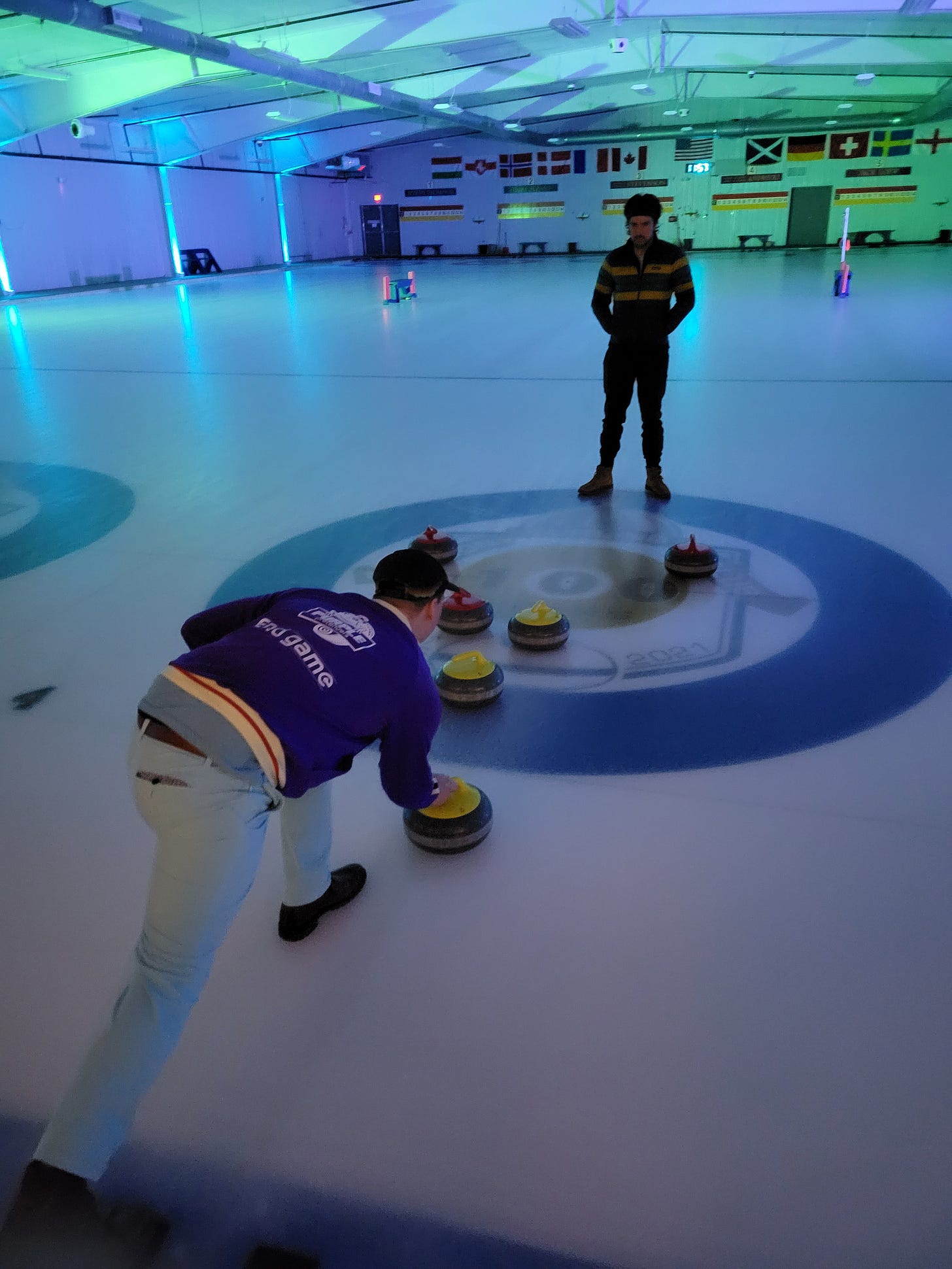The 5U Qualifier Conundrum
How should already-qualified teams be handled at 5-and-under qualifier events?
We’re now fully into national championship season in the United States. Senior curlers and college curlers alike competed this past weekend. Congratulations to Team Smith and Team Farbelow on sweeping the Senior National Championships for St. Paul Curling Club and to UW-Madison on winning the College National Championship!
It’s wild to think the 2025 Club National Championships will be coming up from Milwaukee in just a short couple of weeks.
With the Alaska playdowns now completed (more on that below), the fields are set for Milwaukee. We now await to hear the pool assignments with peer seeding currently ongoing. As I did with arena nationals, you can expect to see both men’s and women’s preview newsletters in the lead up to that event.
Notably, Everest Funeral Concierge recently announced they are no longer sponsoring the Canadian Senior and Canadian Club Championships as they pursue a more involved partnership with World Curling. Unfortunately, I’ve not heard anything positive about a comeback of the Everest North American Curling Club Championships. I hope I’m wrong on that front, but I’m not optimistic. More on club championships will be coming!
In this newsletter, we’ll deeper into a challenging aspect of the existing system for 5U nationals: teams competing in qualifiers after they’ve already qualified. But first, we’ve got one final club playdown to look at out of the Alaska region as well as just one 5-and-Under qualifier that recently completed in Wisconsin.
Club Playdowns Results
Alaska
Women’s Champion: Team Dueber (Anchorage Curling Club)
As with the Midwest Curling Association, only one women’s team registered for the opportunity to represent Alaska at the Club National Championships in Milwaukee. The team from Anchorage also represented Alaska at last year’s championship in Fargo, ND so they should be prepared what to expect for this season.
Men’s Champion: Team Johnson (Fairbanks Curling Club)
Men’s Runner-Up: Team Miller (Fairbanks Curling Club)
When I checked playdowns registrations in January, no men’s teams had yet signed up for Alaska playdowns which led me to wonder if we’d see another wild card team at nationals. Two teams got in just under the deadline to register for the men’s playdown.
Interestingly, the Fairbanks Curling Foundation gives a local team some sponsorship funding to help offset the high cost of travel but only if the team plays in a playdown or qualifier. Had just one team signed up, they would not have been eligible for the sponsorship, but because two teams needed to play down, the funding assistance should help Team Johnson offset costs to get to Wisconsin.
In the best of 3 playdown between the two teams from Fairbanks, Team Miller got off to a hot start in game one with a 9-7 victory, but the Johnson rink fought back to win a close game two. In the rubber match, Johnson was able to pull away and win 9-2 to secure a trip to Milwaukee.
A really good development out of Alaska is that both teams featured curlers who have been active in 5-and-Under and competed at 5U nationals. We’ve generally seen more registrants from 5U in other regions as well, and hopefully this participation in competitive events from newer curlers continues in future years. In addition to some curlers from Team Johnson being involved in the Fairbanks junior curling program, this is a great example of pathways to other national competition regardless of when curlers begin the sport.
5-and-Under Qualifiers Results
Women’s USWCA Racine 5U (Racine, WI)
Winner: Team Carlson (Rocket City Curling Club)
Runner-Up: Team Langham (Denver/San Francisco Bay Area/Triangle/Frogtown Curling Clubs)
For the 2024-2025 season, three qualifier events were awarded to women’s 5U bonspiels. The final of those 3 women’s qualifying events was held at Racine Curling Club with 14 registered teams.
Team Carlson was signed up as a 4-person team, but with lead Jo Smith out, the team was only able to curl with 3 all weekend. Even with all of that, they found themselves on the top of the podium when all was said and done.
Kudos not just to Carlson for winning her second spiel with an entirely different team, but also to Lea Stall and Sara Hammond. Curling is a team game, and the skips don’t win games alone. Stall and Hammond had to execute shots and put their skip in a good spot, and they clearly were able to do that here.
It will be interesting to see how Team Carlson proceeds, as skip Abbey already qualified a Rocket City team early in the season. The USA Curling rules stating a bonspiel winner must register for nationals with 3 of the 4 or 3 of the 5 curlers they played with in their qualification spiel.
Realistically, because they played as a team of 3 in Racine, it would seem Abbey would have to play with the Racine squad, and Smith would need to play with the rest of the team who qualified through Fort Wayne for both squads to be able to compete in St. Paul.
Should the two qualifiers combine forces into one Rocket City rink for nationals, then another runner-up team will be able to find their way to the 5U national championships which leads to a conundrum of sorts.
The 5U Qualifier Conundrum
With the final 5U qualifiers of the season coming up soon, the teams who have qualified for the national championship are working on travel logistics and thinking back fondly on winning a bonspiel to get to St. Paul. In some cases, those teams (and curlers) have a lot to think back on, having won multiple qualifier events.
Every year it tends to be a topic of discussion as teams who have already qualified continue to compete in 5U qualifying bonspiels. As I laid out in early January in my Filling the Fields post, there have been repeat qualifier winners every year of the current system of 5-and-Under qualifying, and this year is no different.
This is another situation where I’m not sure of the correct answer or if there even is one. As the 5-and-Under system in the country has matured, we have generally seen a decline in runner-up teams qualifying.
2023 Nationals: 7 runner-up teams
2024 Nationals: 3 runner-up teams
2025 Nationals: 2 teams (so far)
Let’s try to take a look at this from multiple sides.
The Pros
Keeping Spiels Full
In the 2023-2024 season, I started off my final season of 5U curling at an October qualifier in Phoenix. Unfortunately, we lost in the final, but let’s pretend that final had gone my way. No, I don’t think about this often, what are you talking about?
Before the Coyotes event, I had already registered for the qualifier in Charlotte and booked flights. I could not afford to cancel my flights and other travel accommodations, so canceling was not an option for me. I was going to be there. Even if we had canceled, the organizer would have had to hope a team on the wait list (if there is one) is able to afford and make travel arrangements on short notice.
In some cases, it’s just not feasible for teams to back out, and in other cases, it can leave the organizer in a tough position.
A Stronger National Field
Realistically, a 5U qualifier with a stronger field is going to produce a stronger representative at the national championship. I provided some preliminary numbers on this in my very first Stones & Stripe newsletter where teams from smaller qualifying events or from events who limit entries based on regional memberships tended to not perform as well at the national championships.
In that newsletter, I also wrestled with what to do, and it all comes down to what type of event the 5-and-Under National Championship should be. If we want the best competition, then repeat winners tend to strengthen the field as runners-up from large qualifying are likely to be “stronger” teams as they had more games and potentially more competition to work through to reach the final.
Larger fields are usually stronger fields. Stronger fields tend to lead to stronger qualified teams for nationals. Stronger teams at nationals lead to stronger competition at nationals.
Teams Playing in Their Favorite Spiels
As much as I don’t want to, let’s go back to that hypothetical of me winning the Coyotes 5U in 2023. In addition to Charlotte, I guarantee I would have signed back up for Madison’s Frozen 5-and-Under. Madison’s 5U was the first spiel where I won a game as a skip (and we almost made the A final in that spiel!) as well as my introductions to crokinole, Malört (take that how you will), and horse races.
It was my final year eligible for 5-and-Under, I had attended the spiel the previous two years, and I wanted one last 5U party in Madison. I was going to be there no matter what. Now, how would I have handled our first game of this bracket-style spiel? I can’t say for certain, but there is a high likelihood I try to win one of my favorite bonspiels and improve my peer seeding in the process.
Better Peer Seeding
One of the most unique aspects of this particular championship is that it’s a 24-team, peer-seeded championship where many teams from all parts of the nation are seeing each other for the first time. Teams from Phoenix, Fairbanks, and Boston may have only gone to one local event and qualified for nationals, and yet peer seeding is used to aid in creating equitable pools at nationals.
Last year, I was able to gather data from every qualifier event and shared the information with teams to assist with peer seeding, providing data on teams they might not be familiar with.
Qualified teams at national championships can provide assistance for more accurate peer seeding and thus, potentially more equitable pools at the championship. Selfishly for me, it can provide me a better glimpse of what might lie ahead!
Playing for a Title
In some spiels, the teams are playing for more than just a qualifier spot. The United States Women’s Curling Association (USWCA), one of the early proponents of a national 5U in the country, designates a qualifier as a regional USWCA 5U event. In some cases, this could mean teams are playing for a regional or state 5-and-Under championship as well.
For example, the MoPac (Mountain Pacific) region has had their regional 5U championship also serve as a qualifier. If a team from MoPac wins it, then they are also winning their regional championship, which could carry personal meaning for that team.
Some teams play for those things that have more meaning for them, even if they’ve already qualified for nationals.
The Cons
Spiels Not Getting a Representative
For a bonspiel organizer, this may feel like biggest issue with the existing system. It’s especially true for regions who may feel underrepresented at the national championship.
Imagine hosting a bonspiel in a part of the country where the next closest qualifier requires a significant drive or flight. Now imagine an already-qualified team coming in from a region with a lot of bonspiels and winning the whole thing. Not only did your event not get a local team to qualify, but it might feel like your event is not getting a team at nationals at all.
Technically, that winning team is representing your bonspiel. The better that multi-time winner performs at nationals, the better served your event is for future tiebreakers. But for an organizer, they may not feel as well represented, even if they technically are.
In an interesting scenario this season, two qualified teams matched up in the A final at the Frozen 5U, the largest qualifier in the country. It is common for the Madison runner-up to get a berth to nationals as the first runner-up in, but this year, no new teams qualified through that event.
Getting Eliminated by a Qualified Team
For a bonspiel team, this can feel like an even bigger issue than a spiel not being represented. You’re having a good event, making good shots, having a good time, and you’re starting to picture yourself getting that A-event winner pin and a trip to nationals.
And then you run into a team with nothing to lose. They want to win, but it’s not a big deal if they miss a shot. Maybe they’re a better team than you, maybe they’re not. They don’t have the same pressures you do in the moment, and you end up losing. It’s an awful feeling, to be sure.
On one hand, to be the best, you’ve got to beat the best. On the other hand, losing sucks. Especially when the game might not mean as much for the opponent. Hopefully they buy more than one round when the game is over.
So… what’s the answer?
I don’t know.
For bracket-style events, I don’t entirely mind scenarios where qualified teams play the first game out but concede at the end of the game and move directly into the B event. For events where the top team in a pool moves to the championship bracket, maybe if the top team is already qualified, then they move to the consolation bracket, and you take the next-best team.
But does that make the event less fun? Does it have a negative impact on the national championship itself? Does it unfairly say anything about the teams who do go on to win spiels in those scenarios aren’t as good? After all, teams who competed with no such scenarios at events in the beginning of the season had to play everyone and win.
Just like many of the challenges the 5-and-Under circuit faces, I don’t believe there is a silver bullet, but it certainly gives us a lot to think about how we can make the system as fair and reasonable as possible.
New solutions could potentially include USA Curling owning more of the registration process, putting more restrictions on what constitutes “eligible and not yet qualified” curlers at qualifier events, or overhauling the entire system. Any changes require a big lift, and those same changes are likely going to create other new issues.
For right now, we have to live with the system we’ve got, and ideate on how to ensure 5-and-Under curling is best suited for fairness and capturing adult curlers to the competitive side of the sport.
Coming Up Next…
The Denver Curling Club is hosting the penultimate 5U qualifier of the season starting on Thursday, March 20th. The final qualifier will be held at Rocket City Curling Club April 4-6th. I’ll cover both of those qualifying events in an April newsletter.
For now, the focus of the next few newsletters will be on the 2025 USA Curling Club National Championships in Milwaukee.
If you haven’t yet, be sure to subscribe to receive previews for the men’s and women’s nationals as well as a recap once it’s all said and done. I’ll maybe even be brave enough to try doing some picks again like I did for nationals. What could go wrong?








Interesting post! I would like to hear more about what this means for representation of women (a historically under-represented group) at the 2025 5U Championships. If the Racine winner cedes the slot, it won’t go to another women’s team under the rules, right? So this means that one of just three USWCA bids goes to a men’s/mixed team, which feels fundamentally wrong. The rules need to account for this and to provide for another women’s team to take the bid if the winner does not.